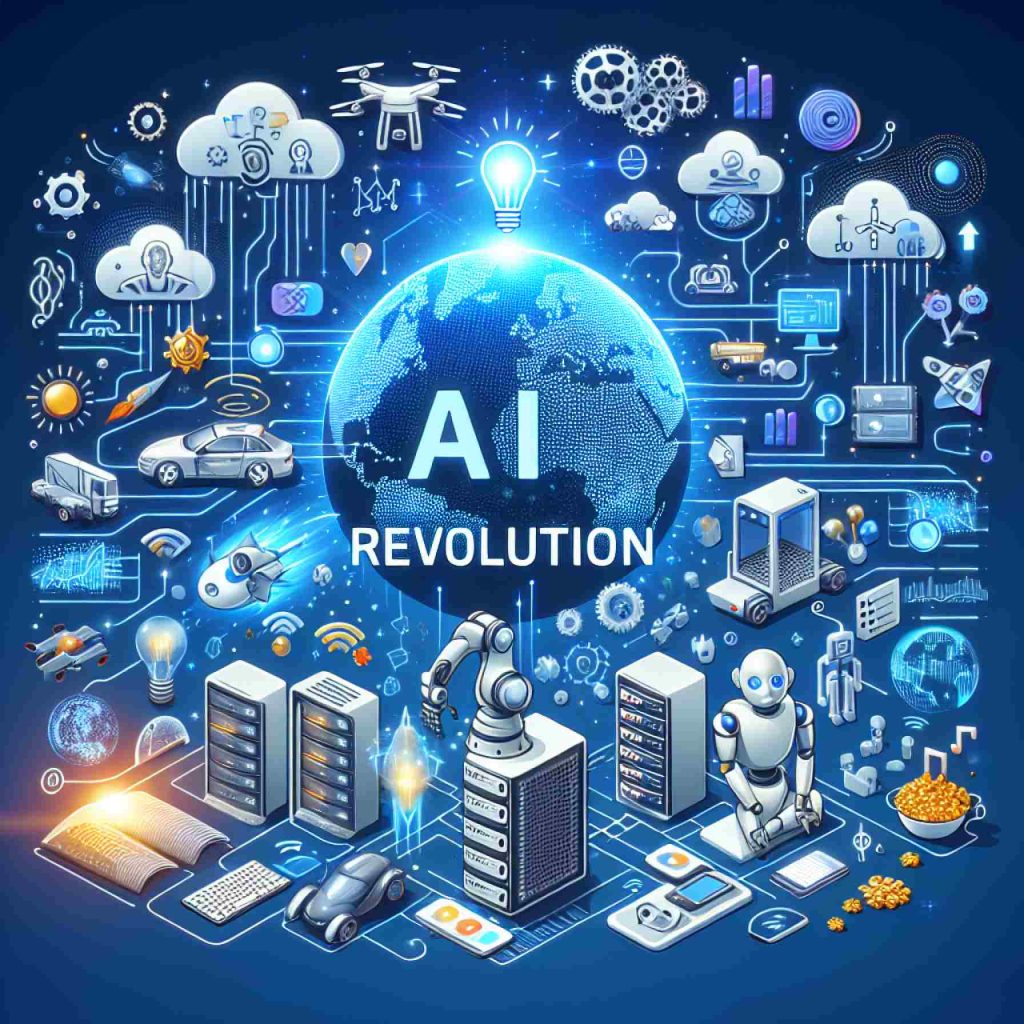
- Artificial intelligence is seamlessly integrating into daily life, profoundly transforming human-machine interaction and automating tasks.
- The global AI market is projected to leap from $407 billion in 2027 to $1.81 trillion by 2030, highlighting unprecedented growth opportunities.
- Microsoft leads the AI revolution, embedding AI into Azure and other consumer products, notably through its strategic partnership with OpenAI and the launch of Copilot.
- With a focus on data analytics, Palantir technologies enhance AI accessibility without specialized language requirements, contributing to significant revenue growth.
- The AI narrative underscores a future where AI transitions from a mere tool to an enduring partner, reshaping industries and offering vast opportunities for investors and stakeholders.
The once unfathomable promise of artificial intelligence is no longer a distant dream—as digital threads of AI weave through the fabric of everyday life, an unprecedented transformation unfurls. As the Industrial Revolution once shifted the landscape of human society in the 1760s, AI now promises to mesmerize the world once more, poised to automate tasks, democratize knowledge, and rethink the essence of human-machine interaction.
AI isn’t just upgrading our digital systems; it is redefining our interaction with the digital cosmos. Natural language processing technologies now enable machines to comprehend and converse with humans in native dialects. Developers and everyday users alike can issue intricate commands in natural language, almost like consulting a well-versed polyglot, to complete tasks that once required fluency in coding.
Eyes cast toward the horizon reveal the formidable potential of the global AI market, projected to soar from $407 billion in 2027 to a staggering $1.81 trillion by 2030. This meteoric rise reflects a 36% compound annual growth rate—an avalanche of opportunity as businesses across sectors embrace AI’s prowess to unlock data-driven decision-making and operational efficiency. The demand for AI solutions is catalyzing industries to leverage the deluge of data—around 400 terabytes generated daily, with 90% conceived in just the last two years—to automate the mundane and unravel complex challenges.
Microsoft stands undeniably at the forefront of capitalizing on this AI boon. With a towering market cap of $3.22 trillion, Microsoft epitomizes tech evolution, cannily infusing AI into its Azure cloud computing platform and proliferating consumer products like Windows and Office. Its Copilot, an intelligent assistant nestled within these software giants, exemplifies seamless integration, executing a plethora of daily tasks without users ever needing to exit their workspace.
Beyond its software marvels, Microsoft’s longstanding investment in AI—highlighted by a strategic alliance with OpenAI—cements its role as a pioneer. Following its near $14 billion stake in OpenAI, the firm carved a pivotal role in ushering ChatGPT into the public’s consciousness. Microsoft’s astute decisions echo through its latest fiscal reports, boasting over $70 billion in revenue, $1.62 billion above estimates, and a robust 21% revenue surge within its Intelligent Cloud suite alone.
Similarly, Palantir Technologies emerges as a luminary in the field of data analytics. Empowering both the public sector and industrial giants like BP and the U.S. Department of Defense, Palantir’s AI Platform (AIP) marries the depth of AI with human insight. Functioning without requiring users to wield specialized languages, Palantir harmonizes the accessibility of its tools with power usually reserved for the tech-savvy. The company’s alliances, from Anthropic to ventures in the finance sector, broaden AI’s reach, transforming narratives in considerable ways. Financial gains follow close behind—a testament to Palantir’s prowess—with a 39% year-over-year increase in revenue in its latest quarterly report.
The AI narrative is a tapestry of innovation, anticipation, and evolving potential. As these titans of technology chart new courses through uncharted waters, they build bridges to a future where AI is not just a tool, but an enduring partner. Mass adoption beckons, driven by the hum of exponential progression. For visionary investors and enthusiastic stakeholders, AI offers a vista not only of profitability but of profound transformation. The real question that lingers is: Are we prepared to embrace a future so different, yet so compellingly bright?
The Unseen Revolution: How AI is Reshaping Our World and What You Need to Know
Artificial Intelligence (AI) has rapidly transitioned from a distant concept to an integral part of our daily lives, reminiscent of the transformative stages of the Industrial Revolution. AI’s integration into various sectors not only automates tasks but fundamentally redefines our interaction with technology. Let’s delve deeper into the nuances of this AI revolution, spotlighting aspects that weren’t fully explored in the initial discussion.
Natural Language Processing and User Engagement
Natural Language Processing (NLP) is advancing AI interactions by allowing machines to understand and respond in human languages. This technology is key in applications like customer service chatbots, virtual assistants like Siri and Alexa, and automated translation services. According to a report by Google AI Research, NLP technology increasingly supports non-English native speakers, promoting inclusivity in digital communication.
How-To Leverage AI in Business
1. Evaluate AI Tools: Identify specific business needs and research AI tools that address these needs effectively. Look for AI software that integrates smoothly with existing platforms.
2. Pilot Programs: Start small with pilot projects to measure AI’s effectiveness. Use feedback to refine and scale successful strategies.
3. Training and Upskilling: Invest in training employees to work effectively alongside AI tools. Platforms like Coursera and edX offer specialized courses in AI and machine learning.
Future Market Trends
The AI market is set to expand aggressively, with forecasts predicting a growth from $407 billion in 2027 to $1.81 trillion by 2030. A significant driver of this growth will be the demand for AI applications in industries like healthcare, finance, and autonomous vehicles. For deeper insights, explore reports by Gartner.
Pros and Cons of AI
Pros:
– Enhanced productivity and operational efficiency.
– Improved customer experiences with tailored and responsive service.
– Data-driven decision-making capabilities.
Cons:
– Ethical concerns related to privacy and data security.
– Possible job displacement due to automation.
– High initial investment costs can be a barrier for small businesses.
Real-World Use Cases
– Healthcare: AI algorithms help in diagnostics by analyzing medical images and predicting patient outcomes. IBM’s Watson, for example, is used to identify treatment options for various forms of cancer.
– Finance: Algorithms are employed to detect fraudulent transactions in real-time. AI also powers robo-advisors that manage investments and optimize portfolios.
Microsoft and Palantir: Leading the AI Charge
Microsoft continues to lead through innovations in AI, particularly with its integration into the Azure platform and applications like Copilot. This intelligent assistant automates numerous tasks within the Microsoft Office suite, streamlining workflows for users.
Palantir Technologies leverages AI for unparalleled data analytics, benefiting the public sector and corporations alike. Their platform allows non-tech users to harness complex data insights, streamlining decision-making processes without requiring programming knowledge.
Actionable Recommendations
– Stay Informed: Keep abreast of AI developments through resources from MIT Technology Review and TechCrunch.
– AI Ethics: Implement ethical AI practices by establishing data privacy and security protocols. Encourage transparency in AI operations.
– Explore Partnerships: Consider collaborations with AI leaders for strategic insights and access to cutting-edge technology.
This transformative era, defined by AI innovation, opens doors to unprecedented opportunities. As businesses and individuals, understanding and embracing these advances will be crucial for capitalizing on AI’s full potential. Embarking on this journey today can align you with the future’s compellingly bright horizon.



